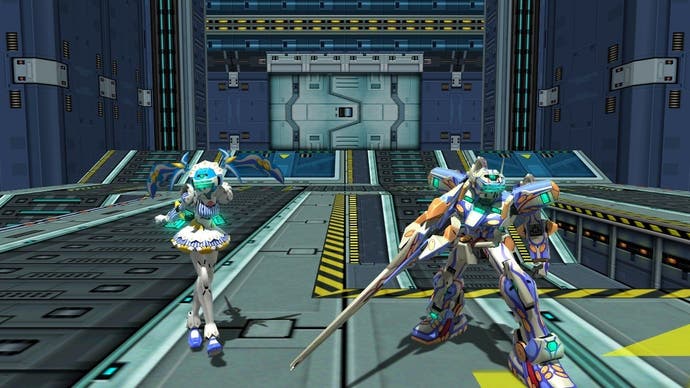Cyber Troopers Virtual-On Force
A force to be wrecking with.
When the original Virtual-On was released in 1995, the story implied that, rather than having been manufactured by SEGA, the sit-down arcade cabinet had been sent from the future in search of capable pilots. Once a suitable candidate had been found and proven their worth by inserting a coin into the mechanism (probably to help stabilise the space-time continuum), it was time to grab the twin sticks and select a Virtuaroid.
These colourful, heavily armed mechs came in many different forms, but rather than tackling a small army with them, players had to battle other Virtuaroids in a fully traversable arena. It was like piloting your own Gundam, and for this reason Virtual-On has seen notable success in Japan. (It's also why the Capcom-developed Gundam VS series is still the most played videogame in Japanese arcades.)
Back west though, Virtual-On is more of a curio, and doesn't have anywhere near the same following, which is a shame, as the mechanical solidarity of this fighter runs deep. It also doesn't help that Europe, up until recently, had been excluded from every Virtual-On bar the original, as we only received the sequel in 2009 courtesy of Xbox Live Arcade. Even then, despite being over a decade old, Virtual-On Oratorio Tangram was, at least for some of us, well worth the wait.
But Tangram isn't the end of this cyber saga, as there are two further sequels in Virtual-On Force and Virtual-On Marz. As a PlayStation 2 exclusive, Marz isn't that hard to track down, and even received a North American release. Force, though, was an arcade game released only in Japan. Now SEGA has not only ported Force to the 360 in Japan, but it's also made the disc region-free.
While all the previous games have been one-on-one fighters, Force shakes things up by making players face off in pairs. It's not just a straightforward slugfest either, as one player gets to be the leader while the other gets the less glamorous title of 'partner'. A team wins by either running down the clock with more health than the opposition or by destroying the enemy leader. It's also possible to score a perfect victory by beating down the partner and then double-teaming the hapless leader.

Those expecting Tangram Tag Tournament Turbo may be disappointed, though, as Force is noticeably slower than its predecessor. This is clearly to make the increased number of projectiles more manageable, but if you're used to the speedier pace of Tangram then adjusting can be tricky. This isn't the only hurdle, as Force also simplifies the control scheme by switching from two Turbo buttons to just one. Nonetheless, the game prides itself on being uniquely hardcore.
Most top-tier Street Fighter players swear by their arcade sticks, and in much the same way those serious about Virtual-On will sing the praises of their twin sticks. After all, both games were designed with their respective interfaces in mind. But with Hori charging around ¥30,000 (£235) for one of its lavish Twin Stick EX controllers, most of us will have to experience Force through a 360 pad.
This wasn't as restrictive as I imagined, because the default setup is fairly intuitive and allowed me to go through the motions with a nippy Apharmd J Virtuaroid unhindered – dashing around the map for some sneaky melee strikes. As before, the ranged combat revolves around mixing up the left, right and centre weapons, fired by pressing the triggers either separately or simultaneously – with the main difference being that each weapon now only has one set of Turbo variations.

